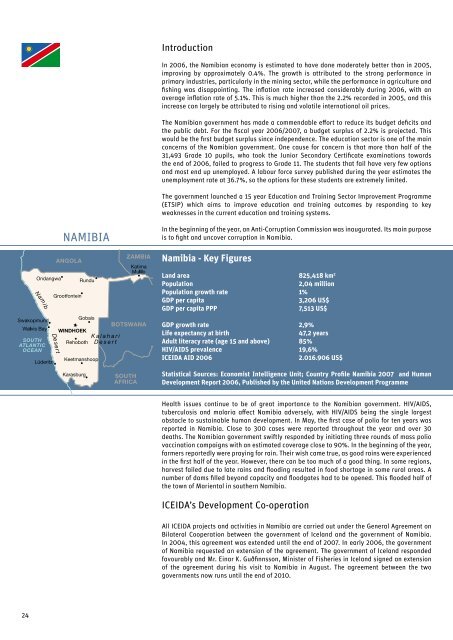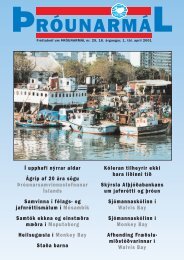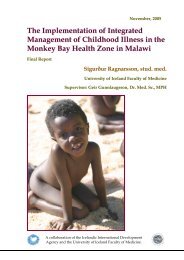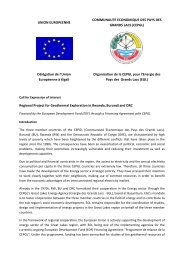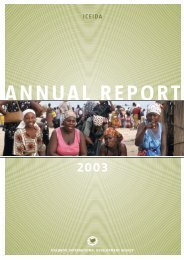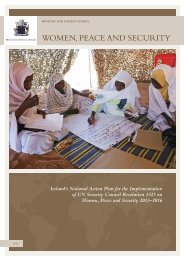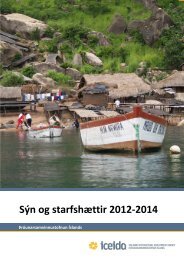You also want an ePaper? Increase the reach of your titles
YUMPU automatically turns print PDFs into web optimized ePapers that Google loves.
Introduction<br />
In <strong>2006</strong>, the Namibian economy is estimated to have done moderately better than in 2005,<br />
improving by approximately 0.4%. The growth is attributed to the strong performance in<br />
primary industries, particularly in the mining sector, while the performance in agriculture and<br />
fishing was disappointing. The inflation rate increased considerably during <strong>2006</strong>, with an<br />
average inflation rate of 5.1%. This is much higher than the 2.2% recorded in 2005, and this<br />
increase can largely be attributed to rising and volatile international oil prices.<br />
The Namibian government has made a commendable effort to reduce its budget deficits and<br />
the public debt. For the fiscal year <strong>2006</strong>/2007, a budget surplus of 2.2% is projected. This<br />
would be the first budget surplus since independence. The education sector is one of the main<br />
concerns of the Namibian government. One cause for concern is that more than half of the<br />
31,493 Grade 10 pupils, who took the Junior Secondary Certificate examinations towards<br />
the end of <strong>2006</strong>, failed to progress to Grade 11. The students that fail have very few options<br />
and most end up unemployed. A labour force survey published during the year estimates the<br />
unemployment rate at 36.7%, so the options for these students are extremely limited.<br />
The government launched a 15 year Education and Training Sector Improvement Programme<br />
(ETSIP) which aims to improve education and training outcomes by responding to key<br />
weaknesses in the current education and training systems.<br />
NAMIBIA<br />
In the beginning of the year, an Anti-Corruption Commission was inaugurated. Its main purpose<br />
is to fight and uncover corruption in Namibia.<br />
Namibia - Key Figures<br />
Land area 825,418 km 2<br />
Population<br />
2,04 million<br />
Population growth rate 1%<br />
GDP per capita<br />
3,206 US$<br />
GDP per capita PPP<br />
7,513 US$<br />
GDP growth rate 2,9%<br />
Life expectancy at birth<br />
47,2 years<br />
Adult literacy rate (age 15 and above) 85%<br />
HIV/AIDS prevalence 19,6%<br />
Iceida AID <strong>2006</strong><br />
2.016.906 US$<br />
Statistical Sources: Economist Intelligence Unit; Country Profile Namibia 2007 and Human<br />
Development <strong>Report</strong> <strong>2006</strong>, Published by the United Nations Development Programme<br />
Health issues continue to be of great importance to the Namibian government. HIV/AIDS,<br />
tuberculosis and malaria affect Namibia adversely, with HIV/AIDS being the single largest<br />
obstacle to sustainable human development. In May, the first case of polio for ten years was<br />
reported in Namibia. Close to 300 cases were reported throughout the year and over 30<br />
deaths. The Namibian government swiftly responded by initiating three rounds of mass polio<br />
vaccination campaigns with an estimated coverage close to 90%. In the beginning of the year,<br />
farmers reportedly were praying for rain. Their wish came true, as good rains were experienced<br />
in the first half of the year. However, there can be too much of a good thing. In some regions,<br />
harvest failed due to late rains and flooding resulted in food shortage in some rural areas. A<br />
number of dams filled beyond capacity and floodgates had to be opened. This flooded half of<br />
the town of Mariental in southern Namibia.<br />
<strong>ICEIDA</strong>’s Development Co-operation<br />
All <strong>ICEIDA</strong> projects and activities in Namibia are carried out under the General Agreement on<br />
Bilateral Cooperation between the government of Iceland and the government of Namibia.<br />
In 2004, this agreement was extended until the end of 2007. In early <strong>2006</strong>, the government<br />
of Namibia requested an extension of the agreement. The government of Iceland responded<br />
favourably and Mr. Einar K. Guðfinnsson, Minister of Fisheries in Iceland signed an extension<br />
of the agreement during his visit to Namibia in August. The agreement between the two<br />
governments now runs until the end of 2010.<br />
24


